A series of two pieces combining text/graphic scores and a custom gestural language, for large-scale ensemble in the telematic medium, created to mark my 20 year anniversary of telematic musicking.
The Original Program Notes for Dispersionology #1:
In the world of physics, dispersion describes a phenomenon in which the rate of propagation of a wave in a medium, its phase velocity, is dependent on its frequency. This can be seen in light, sound, gravity waves, etc. Its a property of telecommunications signals, including the pulses of light in optical fibre cables, describing how the signal broadens and spreads out as it moves across the channel. Dispersion therefore is inherent in the medium that more-and-more binds us these days, in the movements of light pulses that transports our attention, and our listening, around the globe. A beautiful consequence of dispersion is a change in the angle of refraction of different frequencies, leading to a prismatic opening up of a full colour spectrum from incoming light. This ability to broaden out as signals propagate through the network reflects a much wider expansion of distributed listening and sounding that is made possible in the context of telematic musicking. It occurred to me recently that, as of early 2023 I’ve engaged this medium now for 20 years, with an ear towards exploring the myriad ways that the shared real/virtual and nowhere/everywhere site of performance can act as both a point of convergence towards a singular locus of performative attention — yet also a dispersive prism, reflecting individual voices and the preservation of creative agencies of every performer.
I call this current exploration of this phenomenom, at this current milestone moment, “Dispersionology”…. I’ve invited a wide array of past telematic collaborators (spanning this entire 20 years) to explore this and other related tales with me on May 10th. I hope you can join us!
-Doug Van Nort
The concert for piece #1 took place on May 10th as Dispersionology and Other Tales with the following program:
Tuning Meditation
Composer: Pauline Oliveros
Performers: All Sites
Dispersionology
Composer: Doug Van Nort
Performers: All Sites
Other Tales: Algorithmic-chance-structured improvisation
Composer: Doug Van Nort
Performers: All Sites
Performers:
Dispersed/Various Locations:
Chris Anderson-Lundy, Saxophone, Toronto, ON
Tom Bickley, EWI + Max processing, Berkeley, CA
Anne Bourne, cello, Toronto, ON
Cássia Carrascoza Bomfim, flute, Brazil
Chris Chafe, celletto, CCRMA/Palo Alto, CA
Viv Corringham, voice, electronics, New York, NY
Bjorn Eriksson, analog electronics (feedback boxes), Solleftjea, Sweden
Colin James Gibson, guitar, Toronto, ON
Bill Gilliam, piano + electronics, Toronto, ON
Scot Gresham-Lancaster, electronics, Maine
Theodore Haber, violin, Montreal, QC
Glen Hall, Soprano saxophone, contrabass clarinet, Brampton, ON
Holland Hopson, banjo, Tuscaloosa, AL
Rory Hoy, bass + electronics, Brampton, ON
Kai Kubota-Enright, piano (+/- preparation), electronics, Montreal, QC
Al Margolis, violin/contact mic(s)/objects, Chester, NY
Scott L. Miller, Kyma, Minneapolis, MN
Emma Pope, piano, Montreal, QC
Ambrose Pottie, percussion and electronics, Castleton, ON
Dana Reason, piano/inside piano, Oregon State University, Corvallis, Oregon
Omar Shabbar, guitar + electronics, Toronto, ON
Kathy Kennedy, voice + electronics, Montreal, QC
Doug Van Nort, soundpainting, greis/electronics, voice, Toronto, ON
Sarah Weaver, conducting, New York, NY
Zovi, Theremin, Albany, NY
Bogotá (Universidad de Los Andes):
Ricardo Arias, balloons
Leonel Vásquez
(featuring U de Los Andes students)
Chicago (School of the Art Institute of Chicago):
Eric Leonardson, springboard + electronics
Garrett Johnson, electronics
Gordon Fung, electronics
Oslo (Universitetet i Oslo):
Krisin Norderval, voice
Fabian Stordalen, Bass guitar, Guitar, No-input mixing
Kristian Eicke, Guitar (percussive) on lap
Nino Jakeli, Vocals, Guitar, Keyboard
Aysima Baba, Accordion
Alexander Wastnidge, Guitars, Live Electronics
Emin Memis, Ney Flute, Drums
The immersive multi-channel performance – placing the performers at distinct points in the Dispersion Lab space – was recorded with a Zylia 6DOF ambisonic microphone array and is being prepared for future release as a virtual/immersive realization of the piece.
The premiere for piece #2 in this series took place in November 2023 as part of the 2023 NowNet Arts Conference/Festival.










Credits:
Composition and Direction:
Doug Van Nort
Performers – Dispersed/Various Locations:
Chris Anderson-Lundy, Saxophone, Toronto, ON
Tom Bickley, EWI + Max processing, Berkeley, CA
Anne Bourne, cello, Toronto, ON
Cássia Carrascoza Bomfim, flute, Brazil
Chris Chafe, celletto, CCRMA/Palo Alto, CA
Viv Corringham, voice, electronics, New York, NY
Bjorn Eriksson, analog electronics (feedback boxes), Solleftjea, Sweden
Colin James Gibson, guitar, Toronto, ON
Bill Gilliam, piano + electronics, Toronto, ON
Scot Gresham-Lancaster, electronics, Maine
Theodore Haber, violin, Montreal, QC
Glen Hall, Soprano saxophone, contrabass clarinet, Brampton, ON
Holland Hopson, banjo, Tuscaloosa, AL
Rory Hoy, bass + electronics, Brampton, ON
Kai Kubota-Enright, piano (+/- preparation), electronics, Montreal, QC
Al Margolis, violin/contact mic(s)/objects, Chester, NY
Scott L. Miller, Kyma, Minneapolis, MN
Emma Pope, piano, Montreal, QC
Ambrose Pottie, percussion and electronics, Castleton, ON
Dana Reason, piano/inside piano, Oregon State University, Corvallis, Oregon
Omar Shabbar, guitar + electronics, Toronto, ON
Kathy Kennedy, voice + electronics, Montreal, QC
Doug Van Nort, soundpainting, greis/electronics, voice, Toronto, ON
Zovi, Theremin, Albany, NY
Performers – Performance Nodes:
Chicago (School of the Art Institute of Chicago):
Eric Leonardson, springboard + electronics
Garrett Johnson, electronics
Gordon Fung, electronics
Oslo (Universitetet i Oslo):
Krisin Norderval, voice
Fabian Stordalen, Bass guitar, Guitar, No-input mixing
Kristian Eicke, Guitar (percussive) on lap
Nino Jakeli, Vocals, Guitar, Keyboard
Aysima Baba, Accordion
Alexander Wastnidge, Guitars, Live Electronics
Emin Memis, Ney Flute, Drums
Also Broadcasting from Chicago on Free Radio SAIC
In-person audience at Universitetet i Oslo (IMV Salen)
thee Doug Van Nort Electro-Acoustic Orchestra is an ensemble comprised of a mixture of acoustic and electronic performers. It is an emergent sonic organism that evolves through collective attention to all facets of sound, software instruments and text/graphic pieces created by Van Nort, and gesture-based real-time composition in combination with a growing repertoire of these pre-composed structures that are fluidly traversed and integrated spontaneously during performance. The gestural-compositional conducting language used with the group draws upon Van Nort’s experience in electroacoustic improvisation and its unique approach to sound sculpting, shared signal manipulation, the distinct relationships to time/memory/causality that electronics afford, and works that integrate improvisation with pre-composed structures or generative systems. The language is built upon Soundpainting, with many modifications and additions for this project.
This ensemble builds upon the larger Electro-Acoustic Orchestra project, as a more professional and established group which has now had a fixed membership over a longer time scale. This ensemble emerged from the pandemic, integrating select long-term members coming out of the course-based version of the EAO ensemble, with members of the international community of electro/acoustic improvisers (and notably, collaborators from the international Deep Listening community), via telematic connections. The ensemble meets regularly to work through new materials, gestures-concepts and pieces.
The course-based EAO often acts as a pathway to join the professional ensemble for students and professional performer alike. The professional DVN-EAO ensemble has converged to a much higher degree of refinement and specificity, with Van Nort able to compose more involved sonic structures (both electronics as well as text/graphic scores) that are rehearsed and can be called upon and nonlinearly combined in performance, as well as much more “two-way mind reading” that happens in the moment.
thee DVN-EAO regularly performs online and in-person (typically with mixed in-person/telematic performers), and invites proposals for venues and festival performances.
Upcoming and select recent performances include:
November 2023: Ongaku no tomo hall, Tokyo, Japan
December 2022: online/streaming performance for the Winter Solstice
October 2022: keynote performance for the exhibition/symposium Sensoria: The Arts and Science of Our Senses with audiences in Gdansk, Poland and at the Dispersion Lab, featuring immersive haptic/light piece by Van Nort.
May 2022: Elka Bong (Walter Wright and Al Margolis) and thee Doug Van Nort Electro-Acoustic Orchestra in first in-person concert at the Dispersion Lab since the pandemic.
December 2021: Works for the Winter Soltice – online/streaming concert.
June 2021: nO(t)pera Summer Soltice Selections – online/streaming concert.
December 2020: Quarantine: A Telematic nO(t)pera, large scale piece online/streaming concert with audience participation.
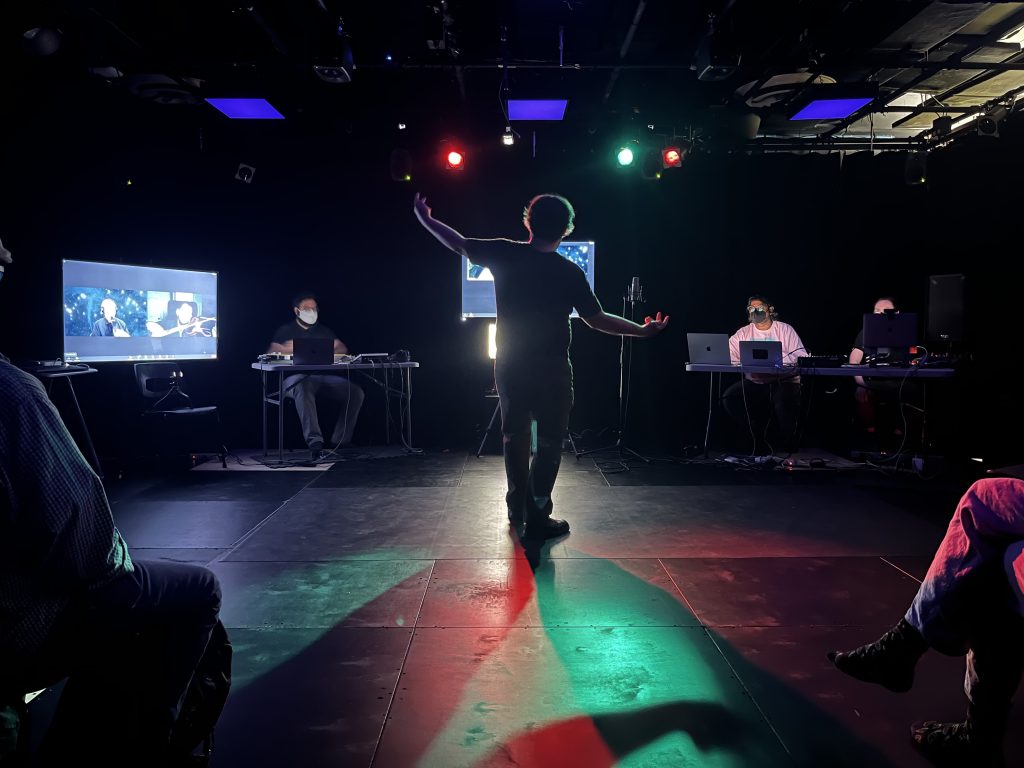










Credits:
Composition and Direction:
Doug Van Nort
thee Doug Van Nort Electro-Acoustic Orchestra:
Chris Anderson-Lundy (saxophone), Tom Bickley (EWI+electronics), Viv Corringham (voice+electronics ), Björn Eriksson (feedback boxes), Rory Hoy (bass+electronics), Kathy Kennedy (voice+electronics), Omar Shabbar (guitar+electronics), Danny Sheahan (violin+electronics), Doug Van Nort (soundpainting/composing/electronics).
Booking:
dispersion[dot]relation[at]gmail[dot]com
Quarantine: A Telematic nO(t)pera is a piece by Doug Van Nort, created for the Electro-Acoustic Orchestra (EAO), for the virtual space of connected isolation, for Casper the cat, and for self-sanity. It is not an Opera, but it is not not an Opera. It is a composition for musical, visual and virtual engagement. The music consists of six movements that span disparate sonic landscapes. It is organized by pre-composed palettes that integrate text, graphics, Soundpainting and software instruments, and are augmented with additional real-time composition via EAO’s unique Soundpainting conducting. This content is a crystallization of ideas that have emerged from months of regular online rehearsals that date back to the beginning of the pandemic, bringing together performers from three continents and numerous time zones. As a meditation on (and a product of) our network-mediated present, the nO(t)pera also introduces diverse networks of improvised collaboration: cross performer-machine collaboration, performer-animal collaboration and audience-machine-performer collaboration.
In one movement of the piece, the audience is invited to improvise drawing input that are interpreted by machine learning algorithms, and in turn will determine the overall structure and sonic content of the music.














Credits:
Composition and Direction:
Doug Van Nort
Electro-Acoustic Orchestra:
Tom Bickley (EWI+electronics), Lo Bil (voice), Viv Corringham (voice+electronics ), Björn Eriksson (feedback boxes), Faadhi Fauzi (synths), Colin James Gibson (guitar), Yuanfen Gu (notpera granular patch), Rory Hoy (bass+electronics), Melanie Jagmohan (guitar+legos), Kathy Kennedy (voice+electronics), Aida Khorsandi (notpera FM patch), Nicholas Lina (bass), Kieran Maraj (kin/electronics), Diane Roblin (inside piano/synths), Omar Shabbar (guitar+electronics), Danny Sheahan (violin+electronics), Peter Vukosavljevic (percussion), Doug Van Nort (conducting/composing).
Live action-or-lack-thereof:
Casper, the cat
Cat-herding and video work:
Stacy Denton
Virtual Staging and visuals:
Rory Hoy
Deep Machine Learning (conducting and drawing recognition):
Kieran Maraj
This project integrates two MYO muscle-sensing armbands, shared-signal sound processing of an electro-acoustic ensemble and gestural recognition of Soundpainting-style conducting. In the project, the Soundpainter shifts modes between guiding performers, collaborating through movement/sound improvisation, and explicitly processing the sonic output of performers through their movements. These shifting modes of interaction require all performers to become attentive to the tensions between acoustic and electronic sources, between their origination point (instrumentalist vs. Soundpainter) and between bottom-up structured improvisation and top-down guiding via conducting. These continuums are amplified and explored through another layer of shared articulation, as machine learning is applied to recognition of the composer/conductors gestures, with symbolic recognition opening up channels of electronic processing and discrete states of potential sound transformation, . The underlying machine learning system is also trained on continuous mappings between conducted motion and sonic transformations, allowing the Soundpainter to perform these transformations through their (now free and unconstrained) movements, continuously co-shaping the output with a given performer. The presence of these two distinct modes of machine-mediation create a tension between the symbology of conducted instruction and that of continuously co-constructed sound, with the Soundpainter and performer sharing signals and intentional resonance in performance. I diagrammed and mapped out this larger human/machine system of listening and co-creation, as can be seen in the below image gallery.
Intersubjective Soundings narrows in on this collective experience as a compositional parameter, allowing for moments of getting “lost” in one another’s sound world and gestural intentions, while needing to pull back to the symbology of soundpainting-based conducting. The work therefore traverses the spectrum of embodied listening-in-the-moment at one extreme, and a reflexive consideration of musical meaning at the other, with both of these modes being mirrored in the movement of the conducting language. This project has been developed in the context of the Electro-Acoustic Orchestra and was premiered at the 2017 International Conference on Movement and Computing (MOCO), with myself at Deptford Town Hall at Goldsmiths University in London, and the EAO at the DisPerSion Lab in Toronto. In this piece, the sense of “listening across” that occurs between instrumental performer and conductor/performer was further heightened through the introduction of a telematic connection between sites.
In 2019 I was invited to present work for a CBC sponsored festival called CRAM. In this context I applied this project to a new piece with another instantiation of EAO, in this case co-located in an acoustically-interesting silo space on York University’s campus known as Vari Hall. We played it twice that evening, and someone was kind enough to post a phone-recorded video of one of the sets.








Credits
Piece Creation/Direction: Doug Van Nort
EAO for the London performance was:
London: Doug Van Nort (composing/conducting, MYO-based transformations)
DisPerSion Lab: Dave Bandi (guitar), Chris Cerpnjak (cymbals, glockenspiel) , Glen Hall (saxophone), Ian Jarvis (catRT+supercollider) , Ian Macchiusi (Moog mother), Mackenzie Perrault (guitar), Danny Sheahan (keys, samples), Fae Sirois (violin), Lauren Wilson (flute)
EAO for the CRAM performance was:
Doug Van Nort (composing/conducting, MYO-based transformations)
Chris Anderson-Lundy (saxophone), Dave Bandi (guitar), Chris Cerpnjak (cymbals, glockenspiel) , Erin Corbett (analog synth), Glen Hall (saxophone), Rory Hoy (bass), Ian Jarvis (catRT+supercollider) , Kieran Maraj (electronics), Ian Macchiusi (Moog mother), Mackenzie Perrault (guitar), Danny Sheahan (violin+electronics), Fae Sirois (violin), Lauren Wilson (flute)
Additional Reference:
Doug Van Nort, Conducting the In-Between: Improvisation and Intersubjective Engagement in Soundpainted Electro/Acoustic Ensemble Performance, Digital Creativity, 29(1), 68-81, 2018.
This project was in collaboration with Thomas Gerwin, connecting the DisPerSion Lab to
Germany. It explored varying modes of attention, including cross-continent gestural interaction between the ensembles. The event connected the lab with the Brandenburg New Music Festival in Potsdam, with performances by the EAO in collaboration with the Stream ensemble. Pieces for this group were created by Doug Van Nort (Canada) and Thomas Gerwin, John Rausek, and Sabine Vogel (Germany), and also included cross-site Soundpainting gestures involving Vogel and Van Nort.








Credits:
Direction: Doug Van Nort and Thomas Gerwin
Performers:
DisPerSion Lab: Electro-Acoustic Orchestra (dir. Doug Van Nort)
Potsdam: Ivo Berg (recorder), Jenny Döll (dance), Reinhard Gagel (accordion, Moog synthesizer),
Thomas Gerwin (banjo, objects, live electronics), Dietrich Petzold (violin,, viola), Sabine Vogel
(Soundpainting)
Composition: Thomas Gerwin, John Rausek, Doug Van Nort, Sabine Vogel
This piece was commissioned by New Adventures in Sound Art (NAISA) for their 2017 Deep Wireless Festival. It was written for the Electro-Acoustic Orchestra with featured violinist Mia Zabelka, and centres around processes and concepts of tuning, fission and fusion.
The concert event, co-produced by Dispersion Lab, NAISA, and Thomas Gerwin at the Exploratorium in Berlin under the theme of “tele-conduction”.





Credits:
Composition:
Doug Van Nort
Performers:
DisPerSion Lab: Dave Bandi, Chris Cerpnjak, Erin Corbett, Ian Jarvis, Ian Macchiusi, Mackenzie Perrault, Fae Sirois, Doug Van Nort, Lauren Wilson
Other Concert Participants:
Berlin: Ivo Berg (recorder), Jenny Doell (dance), Reinhard Gagel (accordion, piano, Mini-Moog),
Thomas Gerwin (banjo, objects, electronics.), Dietrich Petzold (violin, viola)
Compositions: Doug Van Nort, Thomas Gerwin, Sarah Weaver and Glen Hall
Audio Broadcast: NAISA radio
Triple Point – Pauline Oliveros, Doug Van Nort, Jonas Braasch – was an improvising trio whose core instrumentation was soprano saxophone, greis/electronics and V-accordion. The name refers to the point of equilibrium on a phase plot, which acted as metaphor for our improvisational dialogue. Our musical interaction was centered around an interplay between acoustics, physically-modeled acoustics (v-accordion) and electronics. Van Nort captured the sound of the other players on-the-fly, either transforming these in the moment to create blended textures or new sonic gestures, or holding them for return in the near future. Oliveros changed between timbres and “bended” the intended factory sound models through her idiosyncratic use of the virtual instrument, while Braasch explored extended techniques including long circular-breathing tones and multiphonics. This mode of interaction has resulted in situations where acoustic/electronic sources are indistinguishable without very careful listening, while others times this becomes wildly apparent. This continual, fluid morphing is a product of Deep Listening and living in the moment.
“phase/transitions”, a 3-CD set of unedited live improvisation ranging from 2008-2012, was released by Pogus Productions in September 2014. The release features Chris Chafe as a special guest on six tracks.
The trio collaborated on the composition/improvisation project “Quartet for the end of Space” with Francisco López in 2010/2011, also available on Pogus.
In 2009, Triple Point released “Sound Shadows” on the Deep Listening label, which documents a quartet improvisation with Stuart Dempster.
The trio performed together countless time since their inception in 2008, in a variety of festivals and galleries, over the internet with the trio dispersed around the globe, and in experimental exploration of electroacoustic technologies such as machine improvising partners (Van Nort’s FILTER system), automated conducting systems and immersive spatial sound environments based on acoustic modeling of unique spaces.












Triple Point Was:
Pauline Oliveros – accordion/v-accordion
Doug Van Nort – greis/electronics, voice
Jonas Braasch – soprano saxophone
Further Reading:
Doug Van Nort, Multidimensional scratching, sound shaping and Triple Point. Leonardo Music Journal, vol. 20, December 2010.
In 2014, while a Banting Fellow at the Topological Media Lab, I curated two parallel series – one focused on performance and the other on discussion/workshopping/presentation of ideas.
Topological Improvisations was a series presenting improvisations across media, that explored unique topologies of performance: modes of continuity, connectedness and differing boundary conditions, between players and with the space itself. I also took part as a performer in several installments of the series.
These included:
Volume 1: A/V QUARTET ++1: Immersive sound and video, featuring solo/duo/quartet/quintet configurations drawn from: If, Bwana (electronics, objects) / Doug Van Nort (voice, electronics) / Katherine Liberovskaya (live video) / Éric Létourneau (synths, gamelan, wind instruments) / Akunniq (the dog)
Volume 2: TRANSMISSIONS & RESONANCE: A set of improvised sonic explorations, transmission to/from the boundaries of the space. Meditations on the continuity and connectedness of resonance. Julien Ottavi, Erin Sexton, Doug Van Nort in solo/trio combinations.
Volume 3: QUARTETTO TELEMATICO: Pauline Oliveros, Doug Van Nort, Chris Chafe, Jonas Braasch, four site telematic performance for Frontiers Festival, Birmingham, UK.
Volume 4: SINGING IN PLACE: Singing In Place is a live performance. Improvised singing – with and without electronic processing – is used to convey the memory of walks taken. The voice is often combined with field recordings and texts. Viv Corringham solo and in duo with Kathy Kennedy.
Volume 5: MOVING SPACES: Moving Spaces (2002) – Christian Wolff (b. 1934) – Christian Wolff wrote Moving Spaces in 2002 for Loose Time, a work by the Merce Cunningham Dance Company. The piece is rooted in improvisation, ruled by indeterminacy, and energized by noise, silence, and electronic manipulation. The piece was performed by seven improvisers from the Montreal scene: Zach Hale (electronics), Emily Lair (french horn), Molly Wreakes (french horn), Duncan Campbell (trumpet), Felix Del Tredici (bass trombone). Joining them were dancers Bailey Eng and Samantha Rust.
Topological Re-Mediations were a series of workshops and lectures that explored new modes of collective play and co-creation, speculative inquiry and technico-aesthetic innovations in the context of responsive environments.
These included:
Volume 1: HMMM Vocal Workshop with Kathy Kennedy
Volume 2: “Sweet on the Spot” – A presentation and participatory demo on spatial audio with Peter Plessas (IEM, Graz)
Volume 3: Threads: Oana Suteu Khintirian and Navid Navab lecture/demo on “Threads”: Threads is exploring new haptic ways of engaging with paper. Dwelling with the mnemonic dimension of the written word, it puts under the magnifying glass the acts of reading and writing in an intricate play of sensorial relations.
Volume 4: Orbital Resonace: Discussion and Performance. A Research-Creation Project by Margaret Jean Westby and Nikolaos Chandolias In Collaboration with Anne Goldenberg and Doug Van Nort.
Volume 5: Mother of Balloon Music: Judy Dunaway gave a lecture/demonstration about the amazing ways that balloons function as sound makers, offering some history of the balloon in experimental music. This was followed by an audience performance of her “Balloon Symphony No. 2.”
Volume 6: Radius: Jeff Kolar discussed his ongoing curatorial project Radius, an experimental radio broadcast platform based in Chicago, IL, USA. Radius features a new project monthly with statements by artists who use radio as a primary element in their work. Radius provides artists with live and experimental formats in radio programming. The goal is to support work that engages the tonal and public spaces of the electromagnetic spectrum.


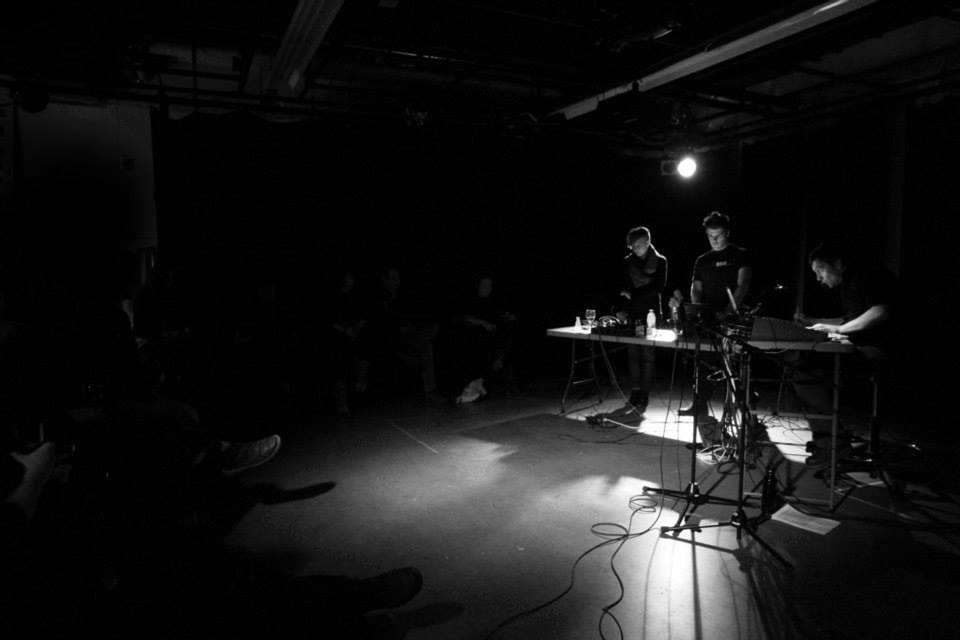



















Credits:
Curation and Performance:
Doug Van Nort
Performers/Presenters:
Various – see above.
Event Promotion, Flyers, Web pages:
Nina Bouchard, Lauren Osmond
Inspirator, Lab Context:
Sha Xin Wei and the Topological Media Lab
A laptop ensemble composition written for and performed by Tintinnabulate at the Arts Center of the Capital Region in Troy, NY. This piece brings together signal-sharing of group tempo and musical key (similar to Awakenings), circuit-bend electronics and also introduced a “human cyborg” performer who could be instructed by audience in another space within the building to engage (or even interference) in the performance, to dance, etc. Audience members were also allowed to come up to a computer located in the performance space running the software instrument, becoming a member of the ensemble. In this way, the piece played with a hyper-localized sense of expanded presence, with breaking down the “fourth wall” of audience-performer engagement, with shared influence of musical structure, as well as hand gestures and a text and graphic-based score, acting as a centering principle for performance actions.





Credits:
Composition and Conception:
Doug Van Nort
Location:
Arts Center of the Capital Region, Troy, NY
Credits:
Performers:
Tintinnabulate (Pauline Oliveros, Doug Van Nort, Jonas Braasch, Evan Gonzalez, Zovi McIntee, Sean)
Audience Participation
Human Robot: Joshua Shinavier
This quartet project involves Pauline Oliveros, Francisco López and Jonas Braasch. It brings together devoted improvisers on one hand and electroacoustic composers on the other. The project explores a new synthesis of improvised electro/acoustics, and studio-based composition. The process has been to begin with free improvisations, from which recordings are then crafted into personal compositions by each member (which have then found their way back into performance, thereby closing the loop). We released an album on Pogus in April 2011, which has received some very nice reviews. This can be purchases directly from me, from Pogus or at the iTunes music store.
Also, my piece Outer was featured in the film Leopardi (aka il Giovane Favoloso), directed by Mario Martone and starring Elio Germano. It was used to underpin an intense scene featuring only the main character, in the film’s final 3.5 minutes.
Excerpts of my pieces from Quartet for the end of Space (Pogus, 2011):
Paralleling my series of Genetic Orchestra pieces, I created two ensemble pieces for acoustic instruments and electronics. The idea was that each sonic gesture is a meme that enters into a system and whose general gestural character evolves over generations, “cross-breeding” with the sounds of fellow performers.
Memetic Orchestra #1 was written for Triple Point and an early version of the FILTER system. It was premiered at the New York City Electroacoustic Music Festival in April 2009. The work explores the use of timbral/textural analysis, gesture recognition and evolutionary algorithms. The sound qualities of the sax and accordion are analyzed and the ‘sonic gestures’ are recognized on the fly by an artificial ‘agent’ who then steers a genetic algorithm, influencing Van Nort’s software performance system. Therefore, acoustic performers influence an agent, who in turn influences the software system that is being performed by a laptop performer who influences the listening of the agent and all are influenced by the overall sound output.
In the first few minutes of this piece the agent controls the sound processing with minor human tuning, and then over the final 7-8 minutes the laptop performer first plays in concert with the agent before taking over to play the GREIS system as well as the evolutionary process itself.
While the piece does explore complex systems and some heavy algorithms (the power of two laptops were needed to run all software), at its heart it is really about listening for all three performers – to the electronic/acoustic balance, to the role of the agent, to the intentions past and present, to the evolutionary trajectory, and so on.
Memetic Orchestra #2 was written for an ensemble of instruments and cross-synthesis algorithms. It was invited for a performance at the Flea Theatre’s “Music with a View” series in November 2009. An exploration in textural transformation and timbral sustain, the piece extracts audio qualities from each player to provide a form within which players articulate subtle inflections, their timbres merging to form a sometimes sparse, sometimes dense collage of each sound’s internal matter.
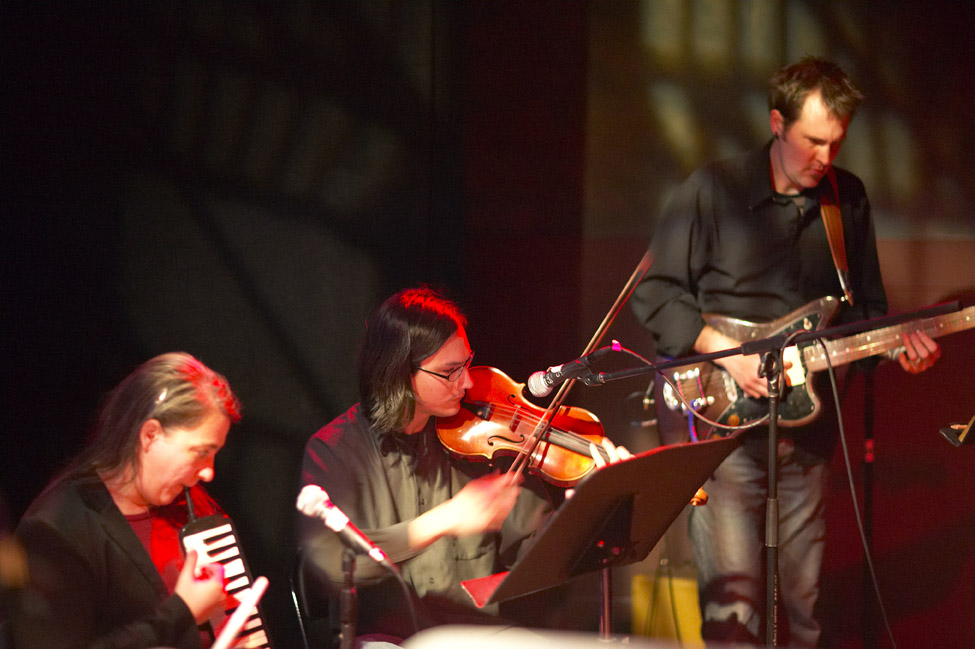
Graphic/Timeline Component of Score for Memetic Orchestra #2:
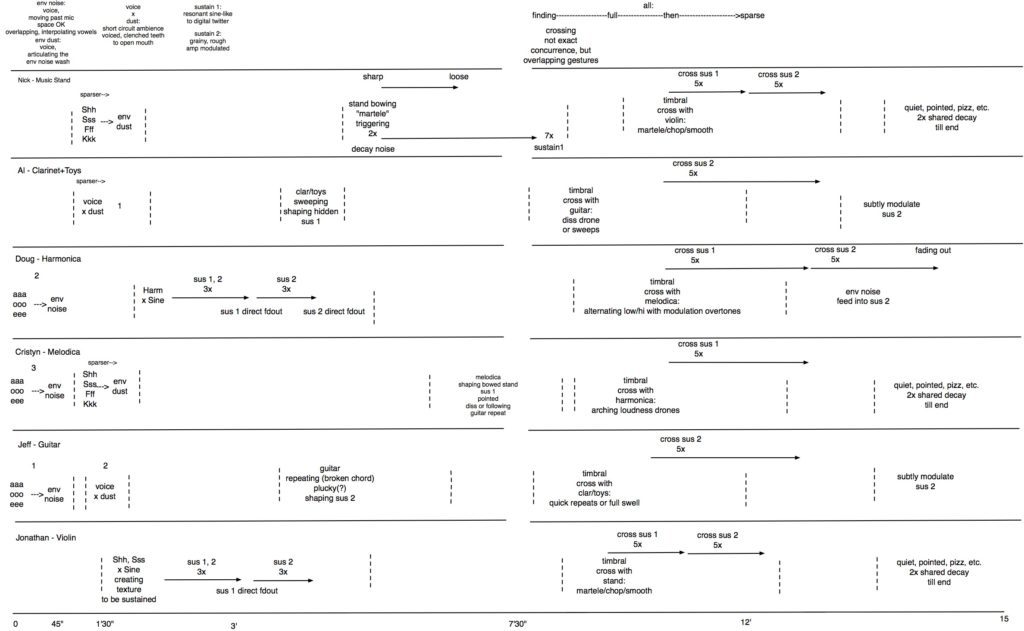
Performers for this premiere included:
Van Nort, harmonica
NF Chase, Bowed Music Stand
Jonathan Chen, Violin
Cristyn Magnus, Melodica
Al Margolis, Clarinet and Toys
Jefferson Pitcher, Electric Guitar
The basic premise of these “laptop orchestra” pieces is that participants somehow rate sound files and more “fit” members of the population are chosen for “mutation” (sound alteration) and “mating” (juxtaposition or morphing of sonic material). Using this genetic algorithm process I have developed a scheme in which performers-turned-sound-mutators rate files which are then selected through an algorithmic process based on the cumulative fitness ratings. In the set of works this evolutionary paradigm is directed by compositional rules, including the nature of the beginning “gene pool” and the type of mutation/crossover. At the same time, the process directs the structure of the score itself, determining the number of sections, number of players in this section, which sonic “generation” each player can draw from and so on. Within these confines, the performance is improvisatory, drawing on each epoch of the evolved sonic gene pool. In this way, there are actually two pieces to speak of: the first is the process and experience of creating this pool — where the participants experience their own sounds and mutations interacting with other players over time. This is an anonymous process where identities and dialogues are formed completely through the digital media. The second piece is the performance and score, when this entire multiple day-or-week process of the pool’s unfolding is collapsed into 20-40 minutes of a performance. Each performer at this point has an intimate understanding of the material, and modulates this pool in attempt to convey this process to a new audience. These series of pieces are collectively titled “Genetic Orchestras”, generally being named “X Genetic Orchestra” where X is the name of the ensemble. There currently exist seven pieces in the repertoire, which have been performed on at least eight occasions, including the International Society of Improvised Music conference in 2007, in performance with the Florida Electronic Arts Ensemble (FLEA) directed by composer Paula Matthusen at several festivals in the Miami area, and by students groups at universities including RPI.
The very first piece was commissioned by the Deep Listening Institute for the “Deep Listening Convergence” event in June of 2007, which brought together 40+ musicians over the internet in a six-month long “virtual residency”, before the final convergence of performances. As such this version is titled “Deep Listening Convergence Genetic Orchestra” or, DLCGO. This version was special not only because it was the first, but because we evolved the piece completely over the internet, and over such a long time period. The recording of the premiere performance was presented on the CD compilation “Listening for Music Through Community” released with the 2009 Leonardo Music Journal. Here is a recording excerpt from DCLGO.
Many version have been performed, such this one in the lobby of EMPAC:
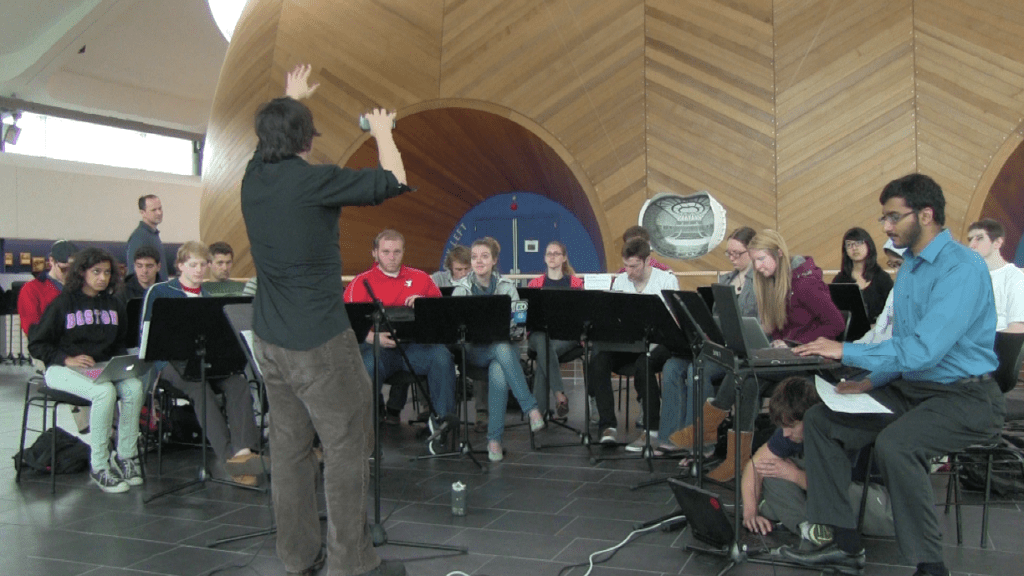
The Toneburst Ensemble at Wesleyan (directed by Paula Matthusen) performed a version that I named ToneGO at the SHARE NYC event in Brooklyn. This is the first piece to include the GA process applied to video – with some really striking results.
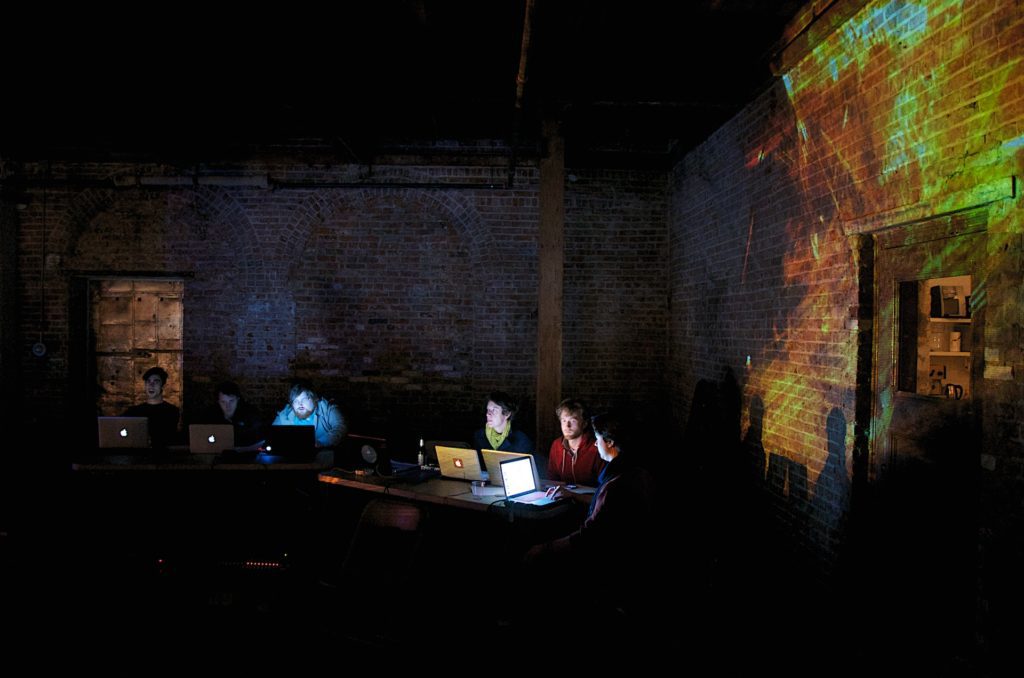
For this series of pieces, I’ve created a simple piece of software that was designed with the intention of allowing players to loop and mix the sound files while independently changing the pitch or timbre. This also allows players to tap in a tempo and to change the character of the sound in simple but uniform ways. This application has become a central part of the pieces, allowing me to compose for the software instrument as well as for the process.